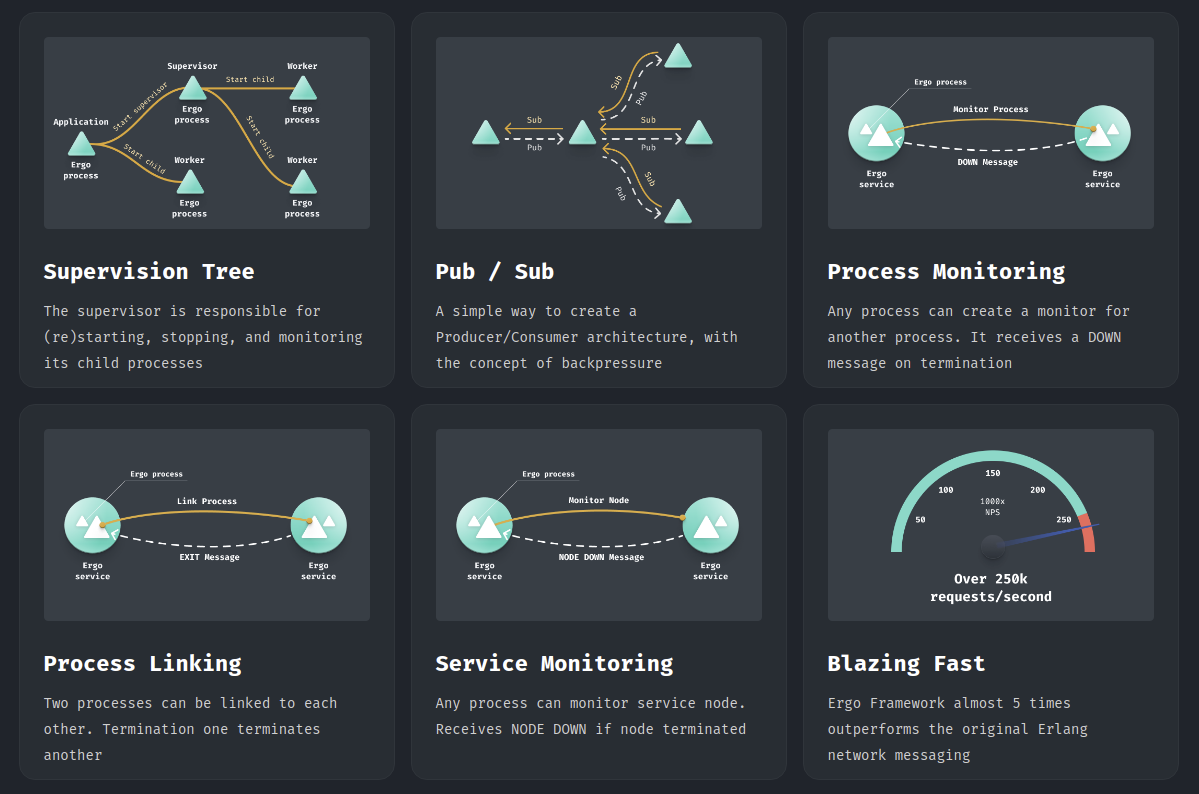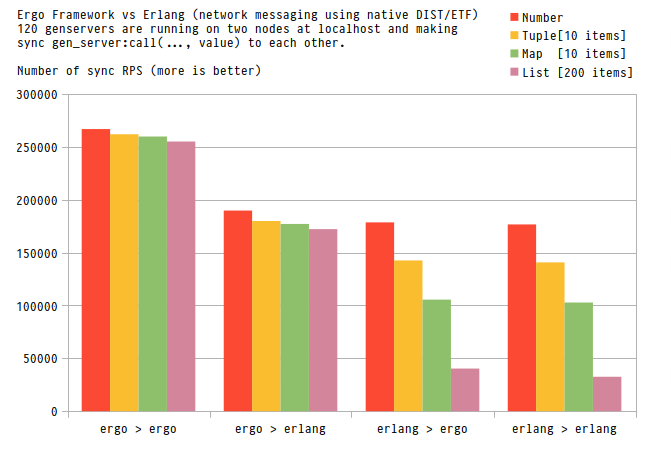






Technologies and design patterns of Erlang/OTP have been proven over the years. Now in Golang.
Up to x5 times faster than original Erlang/OTP in terms of network messaging.
The easiest way to create an OTP-designed application in Golang.
https://ergo.services
Purpose
The goal of this project is to leverage Erlang/OTP experience with Golang performance. Ergo Framework implements DIST protocol, ETF data format and OTP design patterns gen.Server, gen.Supervisor, gen.Application which makes you able to create distributed, high performance and reliable microservice solutions having native integration with Erlang infrastructure
Features

- Support Erlang 24 (including Alias and Remote Spawn features)
- Spawn Erlang-like processes
- Register/unregister processes with simple atom
gen.Server behavior support (with atomic state)gen.Supervisor behavior support with all known restart strategies support
- One For One
- One For All
- Rest For One
- Simple One For One
gen.Application behavior support with all known starting types support
- Permanent
- Temporary
- Transient
gen.Stage behavior support (originated from Elixir's GenStage). This is abstraction built on top of gen.Server to provide a simple way to create a distributed Producer/Consumer architecture, while automatically managing the concept of backpressure. This implementation is fully compatible with Elixir's GenStage. Example is here examples/genstage or just run go run ./examples/genstage to see it in actiongen.Saga behavior support. It implements Saga design pattern - a sequence of transactions that updates each service state and publishes the result (or cancels the transaction or triggers the next transaction step). gen.Saga also provides a feature of interim results (can be used as transaction progress or as a part of pipeline processing), time deadline (to limit transaction lifespan), two-phase commit (to make distributed transaction atomic). Here is example examples/gensaga.gen.Raft behavior support. It's improved implementation of Raft consensus algorithm. The key improvement is using quorum under the hood to manage the leader election process and make the Raft cluster more reliable. This implementation supports quorums of 3, 5, 7, 9, or 11 quorum members. Here is an example of this feature examples/raft.- Connect to (accept connection from) any Erlang/Elixir node within a cluster
- Making sync request
ServerProcess.Call, async - ServerProcess.Cast or Process.Send in fashion of gen_server:call, gen_server:cast, erlang:send accordingly
- Monitor processes/nodes, local/remote
- Link processes local/remote
- RPC callbacks support
- embedded EPMD (in order to get rid of erlang' dependencies)
- Unmarshalling terms into the struct using
etf.TermIntoStruct, etf.TermProplistIntoStruct or to the string using etf.TermToString
- Custom marshaling/unmarshaling via
Marshal and Unmarshal interfaces
- Encryption (TLS 1.3) support (including autogenerating self-signed certificates)
- Compression support (with customization of compression level and threshold). It can be configured for the node or a particular process.
- Proxy support with end-to-end encryption, includeing compression/fragmentation/linking/monitoring features.
- Tested and confirmed support Windows, Darwin (MacOS), Linux, FreeBSD.
- Zero dependencies. All features are implemented using the standard Golang library.
Requirements
Versioning
Golang introduced v2 rule a while ago to solve complicated dependency issues. We found this solution very controversial and there is still a lot of discussion around it. So, we decided to keep the old way for the versioning, but have to use the git tag with v1 as a major version (due to "v2 rule" restrictions). Since now we use git tag pattern 1.999.XYZ where X - major number, Y - minor, Z - patch version.
Changelog
Here are the changes of latest release. For more details see the ChangeLog
v2.1.0 2022-04-19 [tag version v1.999.210]
- Introduced compression feature support. Here are new methods and options to manage this feature:
gen.Process:
SetCompression(enable bool), Compression() boolSetCompressionLevel(level int) bool, CompressionLevel() intSetCompressionThreshold(threshold int) bool, CompressionThreshold() int messages smaller than the threshold will be sent with no compression. The default compression threshold is 1024 bytes.
node.Options:
Compression these settings are used as defaults for the spawning processes
- this feature will be ignored if the receiver is running on either the Erlang or Elixir node
- Introduced proxy feature support with end-to-end encryption.
node.Node new methods:
AddProxyRoute(...), RemoveProxyRoute(...)ProxyRoute(...), ProxyRoutes()NodesIndirect() returns list of connected nodes via proxy connection
node.Options:
Proxy for configuring proxy settings
- includes support (over the proxy connection): compression, fragmentation, link/monitor process, monitor node
- example examples/proxy.
- this feature is not available for the Erlang/Elixir nodes
- Introduced behavior
gen.Raft. It's improved implementation of Raft consensus algorithm. The key improvement is using quorum under the hood to manage the leader election process and make the Raft cluster more reliable. This implementation supports quorums of 3, 5, 7, 9, or 11 quorum members. Here is an example of this feature examples/raft.
- Introduced interfaces to customize network layer
Resolver to replace EPMD routines with your solution (e.g., ZooKeeper or any other service registrar)Handshake allows customizing authorization/authentication processProto provides the way to implement proprietary protocols (e.g., IoT area)
- Other new features:
gen.Process new methods:
NodeUptime(), NodeName(), NodeStop()
gen.ServerProcess new method:
MessageCounter() shows how many messages have been handled by the gen.Server callbacks
gen.ProcessOptions new option:
ProcessFallback allows forward messages to the fallback process if the process mailbox is full. Forwarded messages are wrapped into gen.MessageFallback struct. Related to issue #96.
gen.SupervisorChildSpec and gen.ApplicationChildSpec got option gen.ProcessOptions to customize options for the spawning child processes.
- Improved sending messages by etf.Pid or etf.Alias: methods
gen.Process.Send, gen.ServerProcess.Cast, gen.ServerProcess.Call now return node.ErrProcessIncarnation if a message is sending to the remote process of the previous incarnation (remote node has been restarted). Making monitor on a remote process of the previous incarnation triggers sending gen.MessageDown with reason incarnation.
- Introduced type
gen.EnvKey for the environment variables
- All spawned processes now have the
node.EnvKeyNode variable to get access to the node.Node value.
- Improved performance of local messaging (up to 8 times for some cases)
- Important
node.Options has changed. Make sure to adjust your code.
- Fixed issue #89 (incorrect handling of Call requests)
- Fixed issues #87, #88 and #93 (closing network socket)
- Fixed issue #96 (silently drops message if process mailbox is full)
- Updated minimal requirement of Golang version to 1.17 (go.mod)
- We still keep the rule Zero Dependencies
Benchmarks
Here is simple EndToEnd test demonstrates performance of messaging subsystem
Hardware: workstation with AMD Ryzen Threadripper 3970X (64) @ 3.700GHz
❯❯❯❯ go test -bench=NodeParallel -run=XXX -benchtime=10s
goos: linux
goarch: amd64
pkg: github.com/ergo-services/ergo/tests
cpu: AMD Ryzen Threadripper 3970X 32-Core Processor
BenchmarkNodeParallel-64 4738918 2532 ns/op
BenchmarkNodeParallelSingleNode-64 100000000 429.8 ns/op
PASS
ok github.com/ergo-services/ergo/tests 29.596s
these numbers show almost 500.000 sync requests per second for the network messaging via localhost and 10.000.000 sync requests per second for the local messaging (within a node).
Compression
This benchmark shows the performance of compression for sending 1MB message between two nodes (via a network).
❯❯❯❯ go test -bench=NodeCompression -run=XXX -benchtime=10s
goos: linux
goarch: amd64
pkg: github.com/ergo-services/ergo/tests
cpu: AMD Ryzen Threadripper 3970X 32-Core Processor
BenchmarkNodeCompressionDisabled1MBempty-64 2400 4957483 ns/op
BenchmarkNodeCompressionEnabled1MBempty-64 5769 2088051 ns/op
BenchmarkNodeCompressionEnabled1MBstring-64 5202 2077099 ns/op
PASS
ok github.com/ergo-services/ergo/tests 56.708s
It demonstrates more than 2 times improvement.
Proxy
This benchmark demonstrates how proxy feature and e2e encryption impact a messaging performance.
❯❯❯❯ go test -bench=NodeProxy -run=XXX -benchtime=10s
goos: linux
goarch: amd64
pkg: github.com/ergo-services/ergo/tests
cpu: AMD Ryzen Threadripper 3970X 32-Core Processor
BenchmarkNodeProxy_NodeA_to_NodeC_direct_Message_1KB-64 1908477 6337 ns/op
BenchmarkNodeProxy_NodeA_to_NodeC_via_NodeB_Message_1KB-64 1700984 7062 ns/op
BenchmarkNodeProxy_NodeA_to_NodeC_via_NodeB_Message_1KB_Encrypted-64 1271125 9410 ns/op
PASS
ok github.com/ergo-services/ergo/tests 45.649s
Ergo Framework vs original Erlang/OTP
Hardware: laptop with Intel(R) Core(TM) i5-8265U (4 cores. 8 with HT)

sources of these benchmarks are here
EPMD
Ergo Framework has embedded EPMD implementation in order to run your node without external epmd process needs. By default, it works as a client with erlang' epmd daemon or others ergo's nodes either.
The one thing that makes embedded EPMD different is the behavior of handling connection hangs - if ergo' node is running as an EPMD client and lost connection, it tries either to run its own embedded EPMD service or to restore the lost connection.
Observer
It's a standard Erlang tool. Observer is a graphical tool for observing the characteristics of Erlang systems. The tool Observer displays system information, application supervisor trees, process information.
Here you can see this feature in action using one of the examples:

Examples
Code below is a simple implementation of gen.Server pattern examples/simple
package main
import (
"fmt"
"time"
"github.com/ergo-services/ergo"
"github.com/ergo-services/ergo/etf"
"github.com/ergo-services/ergo/gen"
"github.com/ergo-services/ergo/node"
)
// simple implementation of Server
type simple struct {
gen.Server
}
func (s *simple) HandleInfo(process *gen.ServerProcess, message etf.Term) gen.ServerStatus {
value := message.(int)
fmt.Printf("HandleInfo: %#v \n", message)
if value > 104 {
return gen.ServerStatusStop
}
// sending message with delay
process.SendAfter(process.Self(), value+1, time.Duration(1*time.Second))
return gen.ServerStatusOK
}
func main() {
// create a new node
node, _ := ergo.StartNode("node@localhost", "cookies", node.Options{})
// spawn a new process of gen.Server
process, _ := node.Spawn("gs1", gen.ProcessOptions{}, &simple{})
// send a message to itself
process.Send(process.Self(), 100)
// wait for the process termination.
process.Wait()
fmt.Println("exited")
node.Stop()
}
here is output of this code
$ go run ./examples/simple
HandleInfo: 100
HandleInfo: 101
HandleInfo: 102
HandleInfo: 103
HandleInfo: 104
HandleInfo: 105
exited
See examples/ for more details
Elixir Phoenix Users
Users of the Elixir Phoenix framework might encounter timeouts when trying to connect a Phoenix node
to an ergo node. The reason is that, in addition to global_name_server and net_kernel,
Phoenix attempts to broadcast messages to the pg2 PubSub handler
To work with Phoenix nodes, you must create and register a dedicated pg2 GenServer, and
spawn it inside your node. The spawning process must have "pg2" as a process name:
type Pg2GenServer struct {
gen.Server
}
func main() {
// ...
pg2 := &Pg2GenServer{}
node1, _ := ergo.StartNode("node1@localhost", "cookies", node.Options{})
process, _ := node1.Spawn("pg2", gen.ProcessOptions{}, pg2, nil)
// ...
}
Development and debugging
There are options already defined that you might want to use
-ergo.trace - enable extended debug info-ergo.norecover - disable panic catching-ergo.warning - enable/disable warnings (default: enable)
To enable Golang profiler just add --tags debug in your go run or go build like this:
go run --tags debug ./examples/genserver/demoGenServer.go
Now golang' profiler is available at http://localhost:9009/debug/pprof
To check test coverage:
go test -coverprofile=cover.out ./...
go tool cover -html=cover.out -o coverage.html
To run tests with cleaned test cache:
go vet
go clean -testcache
go test -v ./...
To run benchmarks:
go test -bench=Node -run=X -benchmem
Companies are using Ergo Framework



is your company using Ergo? add your company logo/name here
Commercial support
please, visit https://ergo.services for more information
 Documentation
¶
Documentation
¶










